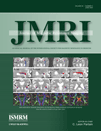Relaxation times of skeletal muscle metabolites at 7T
Abstract
Purpose
To demonstrate the feasibility of quantitatively evaluating and measuring T1 and T2 relaxation times of human tibialis anterior (TA) muscles metabolites in vivo at 7T and to compare these results with those of 3T.
Materials and Methods
A model lipid phantom (corn oil) and healthy volunteers (n = 4, mean ± SD age 35.6 ± 5.6 years) were scanned on 3T and 7T whole-body MR scanners. A voxel of 10 × 10 × 10 mm3 was positioned on the lipid phantom and right calf TA muscles using the single-voxel stimulated echo acquisition mode (STEAM) pulse sequence. All magnetic resonance spectroscopy (MRS) data were processed with Java-based Magnetic Resonance User Interface (JMRUI) using Hankel Lanczos Singular Value Decomposition (HLSVD) filtering to remove the residual water signal.
Results
T1 shows a steady increase while T2 shows a slight decrease with B0 and the spectra show larger spectral resolution at 7T than at 3T in the lipid phantom. T1 values of all the metabolites are higher, while T2 values are slightly lower at 7T than those of 3T compared to reported results in TA. The maximum percentage of increase in T1 is about ≈488%, the maximum percentage of decrease in T2 is about ≈65%.
Conclusion
The preliminary results can potentially be used for calculating relaxation correction factors required for absolute quantitation of skeletal muscle metabolite concentrations and for further protocol and sequence optimization. J. Magn. Reson. Imaging 2009;29:1457–1464. © 2009 Wiley-Liss, Inc.




